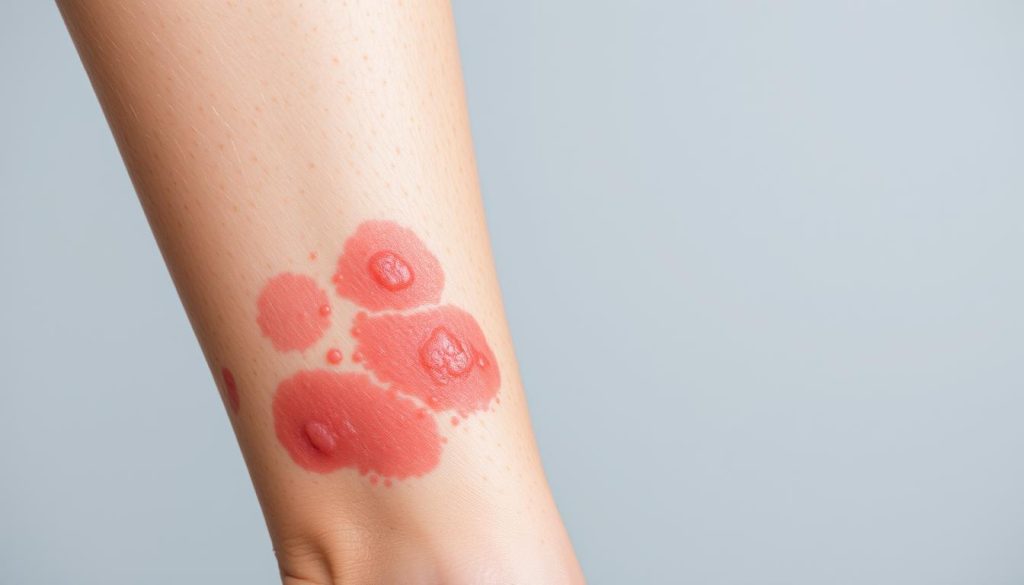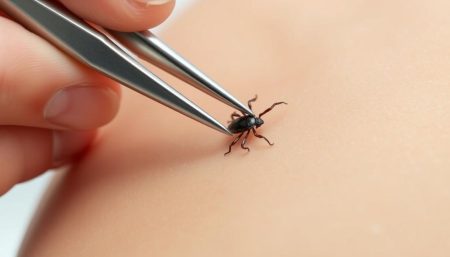A red rash on your leg can be scary and itchy. It means your skin, our biggest organ, is trying to tell you something. It could be a simple irritation or a sign of a bigger skin problem. We’re going to look into why this happens, what it means, and how to make it better.
Leg rashes are common and affect many people. We’ll explore the reasons behind them and the ways to treat them. From simple home remedies to medical treatments, we aim to help you find relief from the itch and the redness on your legs.
Understanding Red Rash on Leg
Understanding skin disorders that cause red rashes on the legs is key. Knowing about skin inflammation helps manage symptoms. Redness and itching, along with other signs, need a detailed look at causes and symptoms.
Defining Dermatological Conditions
Dermatological conditions affect the skin’s structure or function. For leg rash symptoms, knowing these health issues is vital. These can be from simple irritations to serious, systemic disorders causing leg skin inflammation. Persistent redness and itching often mean a serious skin reaction that needs quick action.
Common Characteristics of Skin Irritation
Looking at leg rash symptoms, some signs show the severity and type of skin inflammation. These include:
- Redness: Often the first sign, redness shows inflammation and is a skin response to irritants or infections.
- Itching: A common symptom of dermatitis, itching can be mild or severe and worsen the condition.
- Swelling: In severe cases, swelling appears with redness and itching, showing a strong inflammatory response.
Knowing these symptoms helps people spot early signs of skin conditions and get medical help quickly.

| Symptom | Description | Common Causes |
|---|---|---|
| Redness | Visual sign of inflammation or irritation | Allergic reactions, infections, heat exposure |
| Itching | Sensation that evokes the desire to scratch | Dry skin, eczema, insect bites |
| Swelling | Fluid accumulation and tissue enlargement | Inflammatory diseases, physical trauma |
Identifying Different Types of Leg Rashes
It’s key to know the different types of leg rashes. This helps us tell apart common skin problems from serious ones. We can spot these by looking at how they look and how they make us feel.
Rashes can show up as itchy spots or changes in the skin’s look. Spotting these signs early can help us manage them better and avoid more irritation.
| Type of Rash | Description | Common Symptoms |
|---|---|---|
| Contact Dermatitis | Occurs when the skin comes into contact with an irritant or allergen. | Red bumps on skin, itching, flaky skin |
| Psoriasis | A chronic autoimmune condition that speeds up the growth of skin cells. | Silver-scaly patches, dryness, occasional itching |
| Eczema | A long-term condition causing skin to become itchy, red, and cracked. | Intense itching, dry red patches, blisters |
| Hives (Urticaria) | An outbreak of swollen, pale red bumps on the skin that can appear suddenly. | Red, itchy welts, skin swelling |
- Contact Dermatitis can often be managed with topical creams and avoiding known irritants.
- Psoriasis management might include topical treatments and light therapy.
- Eczema often requires a combination of moisturizers and prescription creams to control flares.
- Hives are typically treated with antihistamines, but chronic cases may require stronger medications.
Knowing how to spot these rashes is a big step in feeling better and avoiding bigger problems. If you have an itchy rash on your leg or red bumps that won’t go away, see a doctor.
Common Causes of Red Rash on Leg
Looking into why leg rashes happen can help us keep our skin healthy. It’s key to know about allergic reactions and infections that cause skin problems. This knowledge helps us take care of our skin early on.
Allergic Reactions and Skin Sensitivities
Allergies often cause skin irritations that show up as leg rashes. Common things that can cause an allergic reaction include:
- Laundry detergents
- Skin care products
- Nickel, found in jewelry and metal fastenings on clothing
- Latex, which is present in many types of elastic bands and rubber products
When the skin touches these allergens, it can react. This can lead to mild redness and itching or even severe blisters and swelling. It’s important to know what you’re sensitive to and avoid those things to prevent reactions.
Infections Leading to Skin Inflammation
Infections are another big reason for leg rashes. Skin inflammation can come from:
- Fungal infections, such as athlete’s foot
- Bacterial infections, which may deteriorate into impetigo or cellulitis
- Viruses like herpes zoster, which causes shingles
Each infection needs its own treatment, like antifungal creams, antibiotics, or antiviral meds. Keeping clean and seeing a doctor early on is key to managing these infections.
Knowing why leg rashes happen and spotting signs of skin irritation is the first step to better skin. Taking action quickly based on the cause can help ease discomfort and stop bigger health problems.
Itchy Rash on Leg: When to Be Concerned
An itchy rash on the leg might seem like a small issue. But sometimes, it can be a sign of a bigger dermatological condition. Knowing when to see a doctor can prevent serious problems with skin irritation.
Watching how a rash grows is important. If it spreads fast, itches a lot, or changes how your skin looks, you should act quickly. Here are some signs you need to watch out for:
- Increased redness or swelling beyond the initial rash area
- Persistent itching that does not improve with over-the-counter remedies
- Development of blisters or open sores
- Signs of infection such as pus, warmth, or severe pain
If you see any of these signs, get medical help right away. A doctor can check you out and start the right treatment. This can stop bigger health problems before they start.
| Symptom | Potential Condition | Advised Action |
|---|---|---|
| Severe itching | Possible allergic reaction or eczema | Consult a dermatologist |
| Blisters forming | Possible infection or inflammatory disease | Seek immediate medical attention |
| Color changes | Possible vascular issues | Schedule an evaluation |
Getting a doctor’s opinion is key if home remedies don’t work. Or if you’ve had allergies or other skin conditions before. Finding the right treatment for skin irritation often depends on acting fast and getting the right treatment.
Red Bumps on Skin: Possible Underlying Issues
When red bumps show up on the skin, it might mean more than just a simple skin problem. It’s important to understand the deeper health issues behind these signs. This part will look at how autoimmune disorders and bacterial infections can cause skin inflammation and red rashes on the leg.
Autoimmune Disorders and Skin Manifestations
Autoimmune disorders attack healthy cells, leading to chronic skin problems. Conditions like lupus and psoriasis cause severe skin inflammation. This can result in red, itchy, and painful rashes on the legs and other parts of the body.
Folliculitis and Other Bacterial Concerns
Bacterial infections like folliculitis happen when bacteria invade hair follicles. This results in red, swollen bumps on the skin. These can be a big problem on the legs, as they can get irritated from clothes and other things.
Folliculitis and similar bacterial infections need quick treatment. This is to stop the infection from spreading and causing more skin inflammation.
| Condition | Symptoms | Common Treatment Approaches |
|---|---|---|
| Lupus | Large red rashes, often butterfly-shaped across the face; joint pain and fatigue | Anti-inflammatory medications, Immunosuppressants |
| Psoriasis | Red patches of skin covered with thick, silvery scales; itching and burning sensations | Topical treatments, Light therapy, Systemic medications |
| Folliculitis | Clusters of small red bumps or white-headed pimples around hair follicles; skin tenderness | Antibacterial washes, Topical creams, Oral antibiotics |
Spotting the signs of autoimmune issues or infections like folliculitis is key. It’s the first step to getting the right treatment. With the right care, most people can control their symptoms and stop further outbreaks.
Redness and Itching: Symptoms to Monitor
Dealing with an itchy rash on leg is not just uncomfortable. It can also be a sign of serious health issues. It’s important to watch for leg rash symptoms and track them over time. This helps spot any changes or new symptoms that might need medical help.
- Increased redness and swelling around the rash
- Persistent itching that intensifies at night
- Changes in the texture or color of the itchy rash on the leg
- The appearance of blisters or oozing, which might indicate infection
Understanding your leg rash symptoms can help find their causes. For example, if the itch gets worse after certain activities or at specific times, it might tell you something about your environment or lifestyle.
Any new symptoms like a spreading rash or burning sensation should get you to see a doctor right away. Keeping a daily log of your symptoms can help you manage your skin condition better.
Diagnosing the Cause of a Red Rash on Leg
Figuring out why you have a red rash on your leg is key to treating it. This usually starts with a visit to a specialist. They might run tests to find out what’s causing your rash.
When to Visit a Dermatologist
See a dermatologist if:
- The rash lasts more than a week, even with home care.
- It’s itchy, painful, or uncomfortable.
- The rash gets worse, showing signs of infection like pus or swelling.
Getting a diagnosis early can stop problems and help find the right treatment for you.
The Role of Allergy Testing in Diagnosis
Allergy tests are very important for finding out why you have a rash. They show which allergens might be causing your skin issue. This lets doctors give you a treatment that really works.
- Patch testing to find out what you’re allergic to.
- Blood tests to see how your immune system reacts.
- Skin prick tests to check for quick allergic reactions.
Knowing what allergens you’re reacting to helps manage and prevent future rashes.
With the right diagnosis and understanding of your rash, you can get the right treatment. This improves your life and skin health a lot.
Leg Rash Symptoms Interpreted by Experts
Healthcare experts, like dermatologists, use many tools and knowledge to figure out and treat leg rash causes. They understand how allergic reactions show up on the skin. This is key to finding out why a leg rash happens.
First, experts take a detailed look at your medical history. They check for any environmental or food triggers. Then, they do a physical exam to see the rash’s details and how bad it is.
They might also suggest blood work or skin biopsies. These tests help find out what’s causing the skin irritation.
- Visual examination of rash pattern and distribution
- Patient history to identify possible allergens
- Diagnostic testing to confirm allergen or irritant
This detailed method helps find the best treatments. It makes symptoms go away and fixes the leg rash causes problem.
Treatment for Red Rash: At-Home Remedies
At-home remedies can help with skin irritation and red rashes. They are gentle and effective. Here, we look at simple ways to ease discomfort and promote healing.
- Aloe Vera: Aloe vera has cooling properties that soothe the skin. It helps with itching and redness. Apply the gel to the affected area for the best results.
- Oatmeal Baths: Oatmeal baths calm inflamed skin and reduce irritation. Soaking in an oatmeal bath for about 15 minutes can help ease skin irritation.
- Coconut Oil: Coconut oil is great for dry, irritated skin. Its hydrating and anti-inflammatory properties make it ideal. Applying it lightly keeps the skin moisturized and reduces itching.
- Cold Compresses: Cold compresses offer quick relief from itching and swelling. Use a damp, cool cloth on the affected area several times a day.
Proper skin care and avoiding irritants are key in treating red rash. Keep your skin hydrated and use mild, fragrance-free products.
These at-home remedies can offer relief, but watch your condition. If symptoms get worse or don’t improve, see a doctor. For ongoing skin issues, a healthcare provider can help diagnose and treat the cause.
Over-the-Counter Solutions for Red Rash on Leg
Many people start with over-the-counter options for an itchy rash on their leg. These products are easy to find at your local pharmacy. They can help ease the symptoms of a red rash. We’ll look at how well topical creams and antihistamines work, and the benefits of moisturizers for healthy skin.
Topical Creams and Antihistamines
Topical creams are great for soothing an itchy rash on your leg. They often have ingredients like corticosteroids or hydrocortisone to reduce inflammation. Antihistamines, on the other hand, fight allergic reactions and can lessen itching and swelling.
These products are easy to use. Just apply them directly to the affected area for quick relief.
Importance of Moisturizing Affected Areas
Keeping irritated skin hydrated is key. Moisturizers not only soothe but also protect against irritants. They help prevent the skin from drying out, which can make a red rash worse.
Using a good moisturizer regularly can greatly improve your skin’s health. It can also help prevent future itchy rashes on your legs.
| Product Type | Active Ingredient | Usage | Benefits |
|---|---|---|---|
| Topical Cream | Hydrocortisone 1% | Apply to affected area up to 4 times daily | Reduces redness and swelling |
| Antihistamine | Diphenhydramine | Take one tablet every 6-8 hours | Relieves itching and allergic reactions |
| Moisturizer | Ceramides and Hyaluronic acid | Apply generously as needed | Hydrates and protects the skin |
Choosing the right products for your skin is important. For mild cases, moisturizers and antihistamines might be enough. But for more serious rashes, you might need topical steroids. Always talk to a healthcare provider if your symptoms don’t improve.
Prescription Medications: What to Expect
Managing a red rash on leg or a complex dermatological condition might need prescription meds. It’s important to know what to expect during treatment. This helps in effectively reducing symptoms.
Dermatologists might prescribe corticosteroids and antibiotics. These are for reducing inflammation and fighting infections. They help if over-the-counter treatments don’t work.
Side Effects: These meds can be very effective but have side effects. Skin thinning, more infections, and hormonal issues are possible with corticosteroids. Antibiotics might change gut bacteria or make infections harder to fight. Always talk to your doctor about these risks.
Learn more about managing symptoms effectively, when using strong prescription meds.
What to Expect During Treatment: You might see improvement in a few days. But, it’s key to finish the treatment as prescribed. This prevents the rash from coming back. Keeping in touch with your dermatologist and watching for side effects are important.
- Monitor skin condition regularly to check for changes or improvements.
- Adhere strictly to dosage instructions provided by your healthcare provider.
- Report any severe or unusual side effects to ensure your treatment plan is adjusted appropriately.
Prescription meds are key for treating serious skin issues. Used right, they can greatly improve your skin and overall health.
Lifestyle Adjustments to Prevent Skin Irritation
Making simple changes in your daily life can help prevent skin irritation. These changes can also improve your skin health. We will look at how to adjust your diet and clothing choices for healthier skin.
The Impact of Diet on Skin Health
Eating the right foods is key to preventing skin irritation. Foods like salmon and flaxseeds are full of omega-3 fatty acids. These help reduce inflammation and can lessen skin flare-ups.
Adding foods rich in antioxidants, like berries and nuts, is also important. They protect your skin from damage caused by free radicals. This can help keep your skin looking clear and healthy.
Choosing the Right Clothing and Fabrics
The clothes you wear can affect your skin health. Opt for fabrics like cotton, silk, and hemp. They are breathable and soft, which is good for your skin.
On the other hand, synthetic materials like polyester can trap moisture and heat. This can make skin conditions worse.
- Wear loose-fitting clothes: Tight clothes can irritate your skin, making it worse during exercise.
- Avoid rough materials: Coarse fabrics can irritate sensitive skin and cause discomfort.
- Select hypoallergenic materials: These fabrics are designed to reduce allergic reactions. They are great for people with sensitive skin.
Alternative Therapies for Skin Care and Relief
Looking into alternative therapies can help with skin inflammation and red rashes. These methods focus on healing the whole body, not just the skin. They might reduce the need for medicines and improve skin health naturally.
Herbal Treatments: Nature has many herbs that fight inflammation. Aloe vera, chamomile, and calendula are great for soothing skin rashes. They can be used as gels, creams, or infusions, making them key for natural skin care.
Essential Oil Applications: Essential oils like tea tree, lavender, and peppermint are good for the skin. When mixed with oils like coconut or jojoba, they can be applied safely. They help ease rash symptoms and support healing.
- Tea Tree Oil – Known for its antibacterial qualities.
- Lavender Oil – Helps soothe the skin and reduce redness.
- Peppermint Oil – Offers a cooling effect on irritated skin.
Stress Reduction Techniques: Stress can make skin conditions worse. Yoga, meditation, and mindfulness help. They improve overall health and can lessen skin symptoms by reducing stress.
Adding these alternative therapies to a treatment plan can greatly improve life for those with skin issues. They offer quick relief and long-term benefits for skin health.
Tracking Your Progress: When to Expect Improvement
Understanding how long it takes for a red rash on leg or skin irritation to heal is key. It helps set realistic goals and see if treatments are working. Here’s a simple way to track your skin’s progress, with tips to note changes and see how well you’re doing.
- Initial Assessment: Take photos and write down details about your skin before starting treatment. Note the area affected, symptoms, and how bad it is.
- Weekly Check-Ins: Update your notes with new photos and observations every week. Compare them to your earlier records to see if things are getting better.
- Adjust Treatments as Needed: If you see changes, talk to a healthcare professional. They can help adjust your treatment plan.
Everyone heals at their own pace, depending on the cause and their health. Here’s a rough guide to what progress might look like for a red rash on leg or skin irritation.
| Time Period | Expected Progress | Notes |
|---|---|---|
| 1-2 Weeks | Reduction in acute symptoms (redness, swelling) | Initial response to treatment should be evident |
| 3-4 Weeks | Noticeable healing and less discomfort | Continue monitoring for any reoccurrence |
| 5-6 Weeks | Significant improvement or complete resolution | If no improvement, consult your dermatologist |
Be patient and keep up with your care plan. If you notice anything different or if symptoms don’t get better, talk to a doctor. Tracking your progress helps you see if treatments are working and lets you take charge of your health.
Community Support: Sharing Tips and Experiences
Dealing with a red rash on leg can be tough. Finding support from others who face similar issues is key. It offers comfort and a chance to share tips and solutions.
People’s stories help each other find relief. They talk about what works for them, like diet changes or skincare. This helps others find hope and practical advice.
Understanding each other’s struggles is important. It shows that we’re not alone in our quest for relief. Support groups and forums are full of valuable advice.
In short, support groups are a treasure trove for those with skin irritation. By sharing, we help ourselves and others. This strengthens our community’s support for each other’s skin health.
FAQ
Q: What are the common causes for a red rash on the leg?
A: Allergic reactions, infections, and autoimmune disorders can cause red rashes. Irritants, insect bites, and heat rashes are also common causes.
Q: When should I be concerned about an itchy rash on my leg?
A: Seek medical help if the rash spreads fast, has fever, or won’t stop itching. Also, if it’s painful, shows signs of infection, or doesn’t get better with home care.
Q: What are some home-based treatment options for red rashes?
A: Try cool compresses, over-the-counter hydrocortisone creams, and antihistamines for itching. Keep the skin moist and avoid scratching.
Q: What type of over-the-counter products can help with a red rash on the leg?
A: Use hydrocortisone cream, calamine lotion, oral antihistamines, and moisturizing lotions. These can help with a red rash.
Q: When is it necessary to see a dermatologist for a leg rash?
A: See a dermatologist if the rash doesn’t get better with home care. Also, if it gets worse or spreads, or if you’re unsure of the cause.
Q: What might a dermatologist prescribe for a severe red rash on the leg?
A: A dermatologist might give you topical steroids, oral steroids, or antibiotics. This depends on the rash’s cause.
Q: How can I prevent future skin irritation and red rashes on my legs?
A: Wear loose, natural fiber clothes and avoid allergens. Use fragrance-free products, stay clean, and apply sunscreen.
Q: Are there any dietary considerations that can affect skin health?
A: Yes, some foods can cause skin reactions. Eat a balanced diet with antioxidants and omega-3s. Avoid processed foods, sugars, and alcohol.
Q: What alternative therapies could be beneficial for treating a red rash on the leg?
A: Aloe vera gel, tea tree oil, and herbal supplements can help. Acupuncture and stress-reduction like yoga and meditation also work for some.
Q: How long before I see improvement in a red rash when following treatment?
A: Improvement can take a few days. If you don’t see changes after a week, or if symptoms get worse, see a doctor.


















